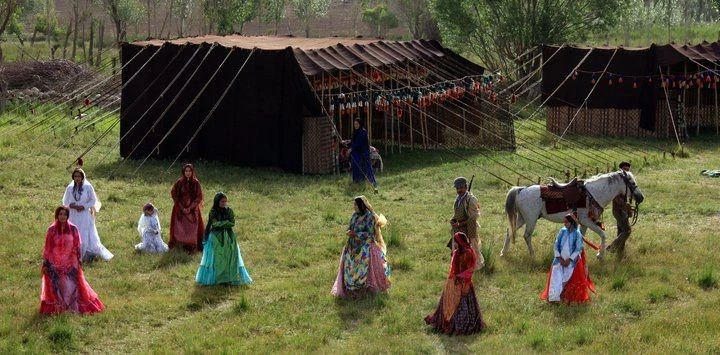For thousands of years, the vast and rugged terrain of Iran has been home to various nomadic communities. These intrepid people have adapted to the harsh conditions of the Iranian plateau, moving with their livestock from one seasonal pasture to another in search of food and water. Although the number of Iranian nomads has decreased in recent decades due to urbanization and government policies, these hardy people still maintain their traditional way of life in many parts of the country. In this blog post, we will take a journey through the fascinating world of Iranian nomads, exploring the history, culture, and lifestyles of different nomadic tribes in Iran.
If you’re eager to experience the life of Iranian nomads firsthand, consider joining one of our Iran Nomad Tours.
Iranian Nomads: A Brief History
Nomadic pastoralism has been a way of life in Iran for over 7,000 years. The Zagros Mountains in western Iran are considered the birthplace of nomadic pastoralism, and it is here that the Bakhtiari and Qashqai tribes still roam today. The Azeri and Shahsavan tribes in the northwest of the country are also notable nomadic communities.
Iranian nomads were traditionally organized into tribes or clans, each with their own leaders and social structure. They moved with their flocks of sheep, goats, and camels from one grazing ground to another according to the seasons, living in tents made of wool and goat hair. Nomads were and still are largely self-sufficient, producing their own food, clothing, and tools.
Nomadic Culture and Customs
Iranian nomads have a rich and diverse culture, with their own music, dance, and oral traditions. They are known for their hospitality and generosity, and often welcome travelers into their tents to share a meal and learn about their way of life. Nomads have a deep connection to nature and the environment, and their knowledge of the land and its resources is passed down from generation to generation through oral traditions. They have a unique understanding of the ecology of the regions they inhabit, and their movements are often dictated by the availability of water and forage for their animals.

Exploring the Diversity of Iranian Nomadic Tribes
Depending on their place of origin and language, Iranian nomad tribes are categorized into different ethnicities.
Bakhtiari
The Bakhtiari nomads are one of the largest and most well-known nomadic tribes in Iran. They live in the western part of the country, particularly in the Zagros Mountains. The Bakhtiari are known for their bravery, their distinctive clothing, and their love of music and dance.
Qashqai
The Qashqai nomads are another large and prominent tribe in Iran. They live in the central and southern part of the country, particularly in the Fars province. The Qashqai are known for their colorful clothing, their intricate carpets, and their strong sense of community.
Shahsavan
The Shahsavan nomads are a Turkic-speaking tribe that live in the northwest of Iran, particularly in the Ardabil province. They are known for their beautiful textiles, which incorporate intricate embroidery and weaving techniques.
Azeri
The Azeri nomads are another Turkic-speaking tribe that live in the northwest of Iran, particularly in the East and West Azerbaijan provinces. They are known for their horsemanship, their distinctive clothing, and their love of poetry and storytelling.
Khamseh
The Khamseh nomads are a confederation of five tribes that live in the Fars province in southern Iran. They are known for their weaving and carpet-making skills, as well as their colorful clothing and jewelry.
Challenges Facing Iranian Nomads
Despite their resilience and adaptability, Iranian nomads face a number of challenges in the modern world. Many nomads have been forced to give up their traditional way of life due to urbanization, government policies, and climate change. As a result, the number of nomads in Iran has decreased significantly in recent decades, and those who still practice nomadic pastoralism often face discrimination and marginalization.
However, there are also efforts underway to preserve and promote nomadic culture in Iran. Nomad tourism is becoming increasingly popular, with travelers from around the world eager to experience the unique lifestyle and culture of Iranian nomads. There are also organizations working to support and empower nomadic communities, such as the Nomads’ House Association and the Nomadic Heritage Center.
Experiencing Nomadic Life in Iran
If you’re interested in experiencing the life of Iranian nomads firsthand, there are a variety of ways to do so. One of the best ways is to join a nomad tour in Iran, which will take you deep into the heart of nomadic communities and give you the opportunity to live and work alongside nomads. You can also visit nomadic markets, such as the ones held in the towns of Yasuj and Shahr-e Kord, where nomads gather to trade goods and socialize.
Nomad Tours and Experiences in Iran
From Persian history to nomadic life in 15 days
Conclusion
Iranian nomads are a vital part of the country’s cultural heritage, and their way of life is a testament to human resilience and adaptability. Although they face many challenges in the modern world, nomads continue to maintain their traditions and customs, and their hospitality and generosity continue to inspire and fascinate travelers from around the world. By experiencing the life of Iranian nomads firsthand, we can gain a deeper understanding of our shared humanity and the diversity of human culture.


0 Comment